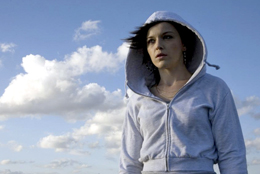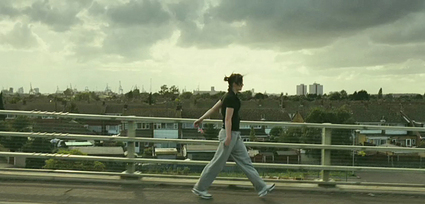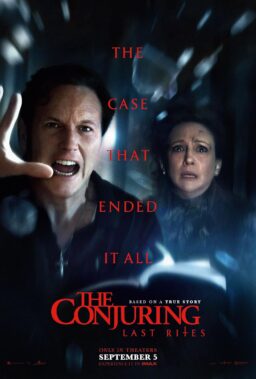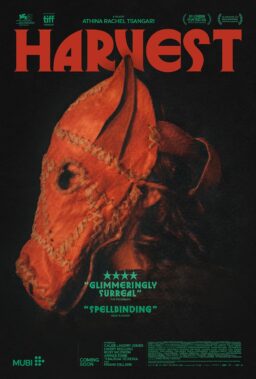
This is the last of my lists of the best films of 2010, and the hardest to name. Call it the Best Art Films. I can’t precisely define an Art Film, but I knew I was seeing one when I saw these. I could also call them Adult Films, if that term hadn’t been devalued by the porn industry. These are films based on the close observation of behavior. They are not mechanical constructions of infinitesimal thrills. They depend on intelligence and empathy to be appreciated.
They also require acting of a precision not necessary in many mass entertainments. They require directors with a clear idea of complex purposes. They require subtleties of lighting and sound that create a self-contained world. Most of all, they require sympathy. The directors care for their characters, and ask us to see them as individuals, not genre emblems. That requires us to see ourselves as individual viewers, not “audience members.” That can be an intimate experience. I found it in these titles, which for one reason or another weren’t on my earlier lists. Maybe next year I’ll just come up with one alphabetical list of all the year’s best films, and call it “The Best Films of 2011, A to Z.”
<img src="https://static.rogerebert.com/redactor_assets/pictures/rogers-journal/the-best-art-films-of-2010/around-a-small-mountain-thumb-425×230-31777.jpg" width="425" height="230" alt="” class=”mt-image-center” style=”text-align: center; display: block; margin: 0px auto 10px; “>“Around a Small Mountain.” Sometimes a film’s message may be no more than that we all have to weather hard times. Maybe that’s what Jacques Rivette has in mind with “Around a Small Mountain.” One of the founders of the French New Wave, Rivette is still active at 82. At his film’s center is a shabby little circus that becomes the stage on which his two characters live. Kate (Jane Birkin) is returning to the circus after 15 years. It was her father’s. Her lover was killed in a performance. When Vittorio (Sergio Castellitto) meets her, she has a quality that strikes him, and books the room above a local cafe on the spur of the moment. When the circus leaves town, he follows. It’s not that he and Kate begin a love affair. It’s that they’ve both run off to join the circus.
He apparently has nowhere to go and nothing else to do, and the same might be said of her. We learn of the buried past of the circus and the buried careers of its performers. Little one-ring circuses like this set up in town squares in rural districts. They still exist. On the Lido in Venice one night, we attended one smaller than this — so small that after the show, the clown came over to our granddaughter Raven and gave her a ride on his mule.
Jane Birkin has a sculpted, intelligent face. She’s a woman who looks like she’s up to something. She’s had quite a life. Here she exudes the loss of her father, her lover and the circus. I doubt if she’s experienced love since her lover died. Vittorio becomes a sort of passive counselor, coaxing her to face her wounds and let go of them. Their relationship is ever so much more interesting than if Rivette had reduced it to romance. This man and woman, strangers, actually find themselves talking to each other. How often do you see that?

“Blue Valentine.” They say we get married because we want a witness. Did Dean and Cindy get married because they wanted someone watching? Or was that Dean’s need, and did Cindy lose the thrill of the watch? Derek Cianfrance, the film’s writer and director, observes the birth and decay of a relationship.Toward the end of the six years, when Cindy is hardly able to remember why she wanted to marry Dean, Cianfrance observes the physical and mental exhaustion that has overcome her. And the way that Dean seems hardly to care — just so long as Cindy remains his wife and his watcher, which in his mind was the deal. Dean thinks marriage is the station. Cindy thought it was the train.
They’re played by Ryan Gosling and Michelle Williams as a Pennsylvania working-class couple with a daughter, Frankie. They give us Dean and Cindy at two ages: their age at present, and at the beginning, when they were filled with that dreamy knowledge that the touch of the other brings quick sensuality. It is easier for an actor to play the same character at 24 and 60 than at 24 and 30. Though some bodily change occurs, what really happens is a transformation of inner certainty. Williams plays a woman who sits inside her body and no longer knows what it’s for and what she wants to do with it.
Dean seems stuck. He seems to stay fixed at the initial stage. Can you see the difference between (1) “He loves me as much as he always did,” and (2) “He loves me exactly like he always did”? “Blue Valentine” moves between past and present as if trying to remember what went wrong. From Dean’s point of view, maybe nothing did. He wanted to be married to Cindy, and he still does and he still is. Cindy can’t stand that. He never signed off on the grow old along with me part. He doesn’t think the best is yet to be. He thinks it’s just fine now.

“Catfish.” Some filmmakers in New York City, who think they’re way cool, get taken apart by a ordinary family in Ishpeming, Mich. You can view this as a cautionary tale about living your emotional life on the Internet. Or possibly the whole thing is a hoax. To go into detail about that might spoil the film’s effect for you. The facts in the film are slippery, but the revelation of a human personality is surprisingly moving.
The film opens in the Manhattan office of Nev, Ariel and Henry, who make videos of modern dancers. Nev has received a painting of one of his photographs from Abby Pierce, an 8-year-old girl. They enter into a correspondence with Abby’s mom, Angela. Nev begins to identify with the whole family. He learns of school plans, pie baking, Sunday family breakfast. Nev and Abby’s older sister, Megan, begin a cyber romance. Nev begins to wonder if this could possibly be the girl for him. There are dozens of photos on her Facebook site, and he even starts using software to put himself and Megan in the same photos.
The three videographers have to fly to Vail to shoot a dance event. On the way back East, they decide to make a detour to Ishpeming. They find the Pierce home and family, and I suppose are welcomed with as much grace as possible under the circumstances. Angela Pierce comes across as an essentially good person, as complex as the heroine of a novel. At the end of the day, I believe she humbles Nev and his friends. I wonder if they agree. They all seem to be nice people. Let’s agree on this: We deserve to share happiness in this world, and if we supply it in the way it’s sought and nobody gets hurt, is that a bad thing?

“Chicago Heights.” Sherwood Anderson‘s Winesburg, Ohio, is a collection of 22 short stories connected by the character George Willard, who comes of age and reflects on the citizens he has grown to know. Perhaps it could inspire 22 short films. Daniel Nearing accomplishes the uncanny feat of distilling the book’s essence.
Anderson’s Winesburg is a town with roads that can be walked along a short distance into the country. His time frame spans the century’s quarter-century. Nearing’s Chicago Heights is a distant Southern suburb of Chicago, bordering on farmland. His time is the present and recent decades. His central character is Nathan Walker (Andre Truss), also played as Old Nathan by William Gray, and at that age named in the credits as Sherwood Anderson. Anderson’s characters were all white. Nearing’s characters are all African-American. Race is not a factor. We are concerned with inner selves.
What Nearing does, and it is rather brilliant, is show us Nathan in old age, under a blanket on his bed, remembering, dreaming or hallucinating about the people he has known. A narrator explains his thoughts. Remarkably for a film of average length, Nearing touches on almost every one of Anderson’s characters, and because of his meditative stylistic approach the film never feels rushed or choppy.
Dialogue slips in and out, as it does in the book, but we’re not intended to think it’s being said now. It’s being heard in memory. Nearing succeeds in establishing it as a place like Winesburg where the countryside is always in walking distance, and one can go there with one’s complexities and feel at peace.

“Daddy Longlegs.” Lenny isn’t a bad father. He’s no father at all. He doesn’t understand being an adult. He doesn’t understand anything. Why did his former wife think she could trust him with two weeks of child custody? Lenny shouldn’t even have custody of himself.
He’s in constant motion during “Daddy Longlegs.” If he has role models at all, they’re provided by his two sons, Sage and Frey. Lenny acts like their playmate, not their father. He’s played by Ronald Bronstein, who projects a relentless upbeat enthusiasm. He tries to baby-sit the kids, who are 5 and 7 years old, while at the same time working as a movie projectionist and dating, or breaking up, with his current girlfriend (Eleonore Hendricks). With one kid riding his shoulders and another tagging behind, he rushes out on unclear missions. At one point, he talks a complete stranger into taking the three of them along on a trip with her boyfriend to upstate New York.
The film was written and directed by Ben and Joshua Safdie. Their cinematic father is obviously John Cassavetes, whose own manic heroes ran crazy loops around their lives. If “Daddy Longlegs” is influenced by Cassavetes, that’s not a bad thing. Few filmmakers have the nerve to travel that path. Bronstein’s performance is crucial. It’s difficult to make a manic character plausible, but he does. He never goes over the top. His mania seems devoted more to lifting off from the bottom. How he ever persuaded his wife (Leah Singer) to marry him is hard to explain, most of all, probably, to herself.

“Fish Tank.” Andrea Arnold‘s “Fish Tank” is the portrait of an angry, isolated 15-year-old girl who is hurtling toward a lifetime of misery. She is so hurt and lonely, we pity her. Her mother barely even sees her. The girl is Mia, played by Katie Jarvis in a harrowing display of hostility. She’s been thrown out of school, is taunted as a weirdo by boys her age, has no friends, converses with her mother and sister in screams and retreats to an empty room to play her music and dance alone. She drinks what little booze she can get her hands on.
And where is her mother? Right there at home, all the time. Joanne (Kierston Wareing) looks so young, she might have had Mia at Mia’s age. Joanne is shorter, busty, dyed blond, a chain-smoker, a party girl. The party is usually in her living room. One day, she brings home Connor (Michael Fassbender), a good-looking guy who seems nice enough. Mia screams at him, too, but it’s a way of getting attention.
One day Connor takes Mia, her mom and her little sister Tyler (Rebecca Griffiths) on a drive to the country. Connor takes Mia wading (“I can’t swim”) in the river. Walking barefoot, she gets a ride on his back and rests her chin on his shoulder, and what was in the air from the first is now manifest. Some reviews call Connor a pedophile. I think he’s more of an immoral opportunist. Arnold sees everything through Mia’s eyes and never steps outside to explain things from any other point of view. She knows who the young girl is, and we are left to assume. Whatever she thinks after the visit to Connor’s house, we are not specifically told.
Katie Jarvis herself may have been headed was heading for a life similar to Mia’s. Her casting in this film, however, led to Cannes, the Jury Prize, and contracts with British and American agents. She is a powerful acting presence, flawlessly convincing here. And Arnold, who won an Oscar for her shattering short film “Wasp” (2003), also about a neglectful alcoholic mother, deserves comparison with a British master director like Ken Loach.

“Jack Goes Boating.” Philip Seymour Hoffman has a gift for playing quickly embarrassed men who fear rejection. We’re on his side without the script needing to persuade us. We want to finish his sentences, clap him on the back, cheer him up. In “Jack Goes Boating,” Hoffman is not only the star but the director, and is merciless in using himself as an actor. His face is often seen in close-up, sweaty, splotchy, red as if perpetually blushing.
In the movie, he plays a limousine driver. At dawn, he meets for coffee with his best friend, Clyde (John Ortiz), and they sit in a parked limo and regard the unattainable towers of Manhattan. Jack is clueless. Clyde is effortless. Even in their 40s, they have a student-teacher relationship. Clyde is going to teach Jack how to chat up a girl, make himself likable. Clyde is married to Lucy (Daphne Rubin-Vega). She works in a funeral home with Connie (Amy Ryan). Connie is the kind of person who you’d describe as sweet, but terribly shy. Clyde and Lucy decide these two people belong with each other perhaps because they appear to belong with nobody else.
This leads into a dinner at which social embarrassment is the main course. The movie is based on an Off-Broadway play by Bob Glaudini, which Hoffman and Ortiz produced and acted in with Rubin-Vega. Its stage origins are suggested by the way Clyde lives in a flat where the kitchen, dining area and the living area are essentially one space — that works beautifully when his dinner for Connie goes wrong, as it must.
You can sense the familiarity the actors have with their roles, but they actors make it new and poignant, and avoid going over the top in the story’s limited psychic and physical space. Even at their highest pitch, the emotions of these characters come from hearts long worn down by the troubles we see.

“Leaves of Grass.” Tim Blake Nelson‘s “Leaves of Grass” is a sweet, wacky masterpiece. It takes all sorts of risks, including a dual role with Edward Norton playing twin brothers, and it pulls them off. It is certainly the most intelligent, philosophical and poetic film I can imagine that involves five murders in the marijuana-dealing community of Oklahoma.
The film opens with Norton as a philosopher named Bill Kincaid giving a lecture on Socrates to a packed classroom of star-struck students at Brown. What an audacious way that is to open a movie about the drug culture of rural Oklahoma. Kincaid gets a telephone call telling him his twin brother Brady is dead. He flies home for the funeral, and is met at the airport by his twin’s best friend (Nelson). It turns out the story was a lie to lure him back home for two purposes. One is to force him to see his mother, a 1960s pothead played by Susan Sarandon. The other is to act as Brady’s double to establish an alibi while Brady goes up to Tulsa for a meeting with the region’s dominant marijuana dealer (Richard Dreyfuss).
Norton is flawless as both an elite intellectual and a good ol’ boy. He’s for all intents two different people, one who has reinvented himself, the other who is growing the best marijuana around. I like the way the film makes the twins equally brilliant; Brady has designed and built a hydroponic farm that is producing its seventh generation of top-quality weed. He is also something of a philosopher himself.
Another valuable character is Janet (Keri Russell), a local English teacher and poet, who quotes Whitman to Billy and entrances him in a way he has never before allowed. The plot involves as many dead and severely wounded bodies lying around as in “Blood Simple,” and Nelson weaves it expertly without a lot of visible “plotting.” The story is the terrain the characters move through, and they are always the foreground. What stands out is the ability of both Billy and Brady (perhaps even more Brady) to understand the world philosophically and deal with it intellectually.

“Mother and Child.” Three mothers in need of a child. Three children, one not yet born. Three lives that are obscurely linked. Rodrigo Garcia has made his career with films sympathetic to the feelings of women, and his “Mother and Child” is so emotionally affecting because it is concerned only with their feelings. The film is founded on three performances by Annette Bening, Kerry Washington and Naomi Watts. Bening plays Karen, a caregiver at work, where she’s a physical therapist, and at home, where she cares for her mother. There will be no one to care for her: When she was 14, she gave up a child for adoption, and now she yearns to have that child back. This is not a film about the wisdom of adoption, however, but about Karen’s desire for her child. Kerry Washington plays Lucy, happily married, childless, trying to adopt a child. Naomi Watts is Elizabeth, a lawyer who is concentrated not so much on her career but on her power, and how her sexuality can be a part of that.
A quiet, nurturing person at the intersection of these lives is Sister Joanne (Cherry Jones), a nun at a church adoption bureau. She is childless, of course, but content; she accepts her state as part of her service to God and is devoted to her clients. The nun is one of several important supporting characters who give “Mother and Child” richness. In this large cast, the actors are gifted and well-cast down to the smaller roles, and each one is important to the development of the story — not just added for diversion or variety.
Garcia, whose credits include “Things You Can Tell Just by Looking at Her” (2000) and “Nine Lives” (2005), has created an interwoven plot not just for the purpose of being clever. Each facet revolves to illuminate the others. The characters reflect aspects of the central dilemma of the childless mothers. It doesn’t argue that all mothers require children, and indeed the nun may be the happiest woman here. It simply argues that these mothers believe that they do.

“Please Give.” There is an evil-tempered old woman in “Please Give” who finds fault with everyone and everything. Her next-door neighbors are waiting for her to die so they can break through her walls. The old lady, Andra, is played by Ann Guilbert with exact cunning, and looked after by her granddaughters. Rebecca (Rebecca Hall), constant and kind, and Mary (Amanda Peet), a distracted heavy drinker.
The couple next door are Kate and Alex (Catherine Keener and Oliver Platt). They run an antique furniture store specializing in furniture from the 1950s. Kate is one of those Keener characters you feel like you’ve known somewhere before. They have a daughter, Abby (Sarah Steele), who is pudgy, has skin problems and is antisocial, but smart and has good timing. Abby is incredulous at the way her mom is a pushover for street beggars; Kate can hardly enjoy a meal without taking a doggie bag to a homeless man.
Kate and Alex are reasonably happy. They run errands for Andra to calm their consciences, and have a dinner party for the old lady and her granddaughters. This scene by writer-director Nicole Holofcener is an exercise in social embarrassment, one of those Bunuelian scenes in which people unexpectedly tell the truth and say what should not be said. Holofcener pays close attention to women. She doesn’t define them by their relationships with men. In a Holofcener movie, women actually have their own reasons for doing things — and these are even allowed to be bad reasons. The movie is about imperfect characters in a difficult world, who mostly do the best they can, but not always. Do you realize what a revolutionary approach that is for a movie these days?

“A Prophet.” The murder at the center of Jacques Audiard‘s “A Prophet” that is clumsy, messy and brutal, and leaves the killer shaking. Whether he shakes with grief, relief or anger we cannot say. That’s the key to this film, which follows the life of Malik, a young Frenchman of Arab descent, who enters prison as a naive outsider and is shaped into an evil, adult criminal. He was born a shy, passive loser. Prison made him all that he can be. He seems an unlikely protagonist for a prison movie. Prison serves him over to the Corsican gang that controls everything behind bars.
This gang is run by Cesar Luciani (Niels Arestrup), a man who has the presence of Don Corleone but colder eyes. He walks everywhere followed by bodyguards. He makes it his business to intimidate the new man. There is a prisoner who Cesar wants killed. Malik is instructed by Cesar’s lieutenant how to conceal a razor blade in his mouth and slit the man’s throat. It is very simple. If Malik doesn’t do this, he will die.
In the years to come, Malik undergoes a transformation. He learns how to observe, how to devise strategy, how to rise. “A Prophet” becomes his bleak, remorseless coming of age story. But what goes on inside Malik? That’s the frightening part. We can only judge by what he does. Now he is prepared to kill. Prison has prepared him to return to the streets.

“Rare Exports.” How to explain an R-rated Santa Claus origin story crossed with “The Thing?” It is the day before Christmas in the far Arctic north. Young Pietari lives on a reindeer ranch with his dad and other men, and nearby there is a huge mound that looks vaguely sinister. The Americans have been blasting away up there with dynamite. Very sinister. Pietari and his friend Juuso have been sneaking through the fence to spy on the Yanks. “
There is a legend that centuries ago the citizens were threatened by fearsome monsters. They were able to trick them onto the lake, where they froze. One of them was cut out inside a giant block of ice and buried deep beneath the mound. And now, Pietari is the only one who figures out that inside the mound, inside the ice, is Santa Claus.
Well, not Santa precisely. A savage, scrawny beast of a man with a beard, who eventually does admittedly end up wearing a Santa suit, but strictly for warmth. Don’t let it get lost in the confusion that this is a fine film. An original, daring, carefully crafted film, that never for one instant winks at us that it’s a parody. In its tone, acting, location work, music and inexorably mounting suspense, this is an exemplary horror film, apart from the detail that they’re not usually subtitled “A Christmas Tale” and tell about wild Santas.

“Somewhere.” Johnny Marco (Stephen Dorff) sits in a Hollywood hotel suite, and finds himself a hollow man. He is a movie star. With that comes money, fame, sex, drugs. Fame is a joke because he gets nothing from it. Sex involves mechanical manipulations of the genitals. He drinks and takes drugs but pleasure doesn’t seem to be involved. Sofia Coppola‘s film involves, as did her “Lost in Translation” (2003), a man separated from his family and sitting alone in a hotel room. In “Lost in Translation,” Bill Murray‘s Bob made dutiful but cheerless phone calls home from Japan. Dorff’s Johnny spends dutiful time with his 11-year-old daughter Cleo (Elle Fanning). Neither seems meaningfully connected.
The notion of a star sinking into seclusion and depression isn’t new. What distinguishes Coppola’s film is the detail in her portrait of celebrity life. Remember that she was a little girl and later a young actress on the sets of her father’s movies. Now that we see how observant she is, we can only speculate about what she understood right from the start. She played Michael Corleone’s baby.
Her hero seems to suffer from anhedonia, the inability to feel pleasure. Johnny stares at the wall and the film stares back. Coppola sees, and we see exactly what she sees. There is little attempt here to observe a plot. All the attention is on the handful of characters and on Johnny. He has attained success and lost track of the ability to experience it. Perhaps you can stimulate yourself so much for so long that your sensitivity wears out. If Johnny has no inner life and his outer life no longer matters, then he’s right: He’s nothing.

“Tiny Furniture.” Aura has graduated from college and returned home to live in her mother’s Tribeca loft in Tribeca.Four years of education have left her with one video on YouTube. Her mother is a famous artist who makes a lot of money selling photographs of tiny furniture, sometimes in the same frame as the feet and legs of Nadine, Aura’s sister, who is taller, thinner and younger than Aura.
Aura (Lena Dunham) is discontented. She hates living at home but has no money to move out. She wants love and acceptance, and finds it much diluted by her distracted mother (Laurie Simmons) and her competitive sister (Grace Dunham). Of possible boyfriends there are: (1) Jed, a “big deal on YouTube,” which shows him riding a mechanical pony while reciting Nietzsche, and (2) Keith, who works at the restaurant and has a girlfriend but asks Aura out and then stands her up.
Aura’s life unfolds without plot because there is none. This is a movie about people who are all passive-aggressive, including Aura. Nobody laughs or tries to say anything funny, and when Aura is happy sometimes, she doesn’t trust it. Aura is played by Lena Dunham, who wrote and directed the film. Her mother and her sister are played by her real mother and sister. The loft in Tribeca is where her family lives. Visually, the film is as unadorned as the white cabinets that cover a wall of the loft. Dunham’s cinematographer, Jody Lee Lipes, doesn’t move the camera. It’s locked down for a steady, flat gaze. This is correct. It sees like Aura sees. Her personality doesn’t suggest tracking shots.

“Yellow Handkerchief.” This is the story of three insecure drifters who find themselves sharing a big convertible and driving to New Orleans not long after Hurricane Katrina. The car’s driver is a teenager named Gordy (Eddie Redmayne), who doubts most of what he does and seems to apologize just by standing there. At a rural convenience store, he encounters Martine (Kristen Stewart), running away from her life. He says he’s driving to New Orleans. No reason. She decides to come along. No reason. They meet a quiet, reserved man named Brett (William Hurt), and she thinks he should come along. No particular reason.
We now have the makings of a classic road picture. Three outsiders, a fabled destination, Louisiana back roads and a big old convertible. William Hurt occupies the silent center of the film. In many movies we interpret his reticence as masking intelligence. Here we realize it’s a blank slate, and could be masking anything. Kristen Stewart is a wonderful actress. I must not hold the “Twilight” movies against her. In recent film after film, she shows a sure hand and an intrinsic power. I last saw her in “Welcome to the Rileys,” where she played a runaway working as a hooker in New Orleans. In both films she had many scenes with experienced older actors (Hurt, James Gandolfini). In both she was rock solid. The story of Redmayne, who plays Gordy, is unexpected. He fits effortlessly into the role of the scrawny, uncertain 15-year-old Louisiana kid. Yet I learn he is 27, a Brit who went to Eton, a veteran of Shakespeare and Edward Albee.
During their odyssey their secrets are slowly confided. They learn lessons about themselves, which is required in such films, but are so slowly and convincingly arrived at here that we forgive them. Prasad made a wonderful British film in 1997, “My Son the Fanatic.” I’ve seen none of his work since. Now comes this redneck slice of life. Since the characters are so far from the lives of the actors and the director, this is a creation of the imagination. As it must be. The ending is a shade melodramatic, but what the heck. In for one yellow handkerchief, in for a hundred.











